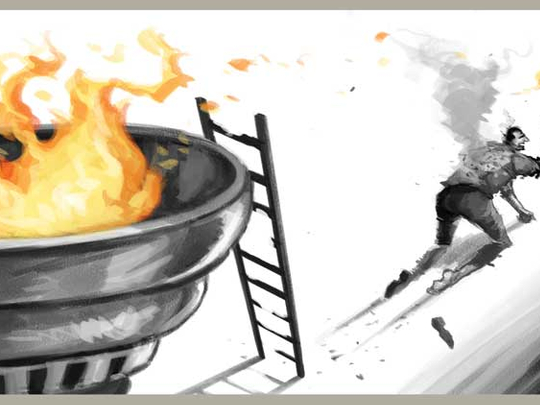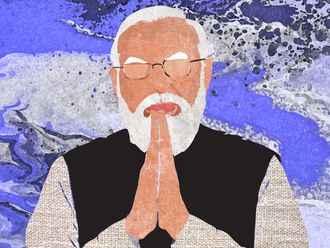
“The ragtag revolutionary militias that formed to topple Muammar Gaddafi — with Nato’s help — were once beloved. Today, they are their nation’s biggest problem,” a Boston Globe editorial last Friday said. The assertion underscores the seismic shift witnessed in Libya in 2013. One could argue that the deteriorating situation in Libya is a microcosm of what has befallen other so-called Arab Spring countries, where the gains of revolutions were reversed due to internal conflicts between political elites or simply seized through military takeover. Libya today is caught between many chaotic forces: Political groups with dubious loyalties, foreign agendas, tribal interests and hundreds of militias, some of which are affiliated with major tribes, clans and politicians. Murder, rape and kidnappings are now regular occurrences in Libya. Prime Minister Ali Zeidan was himself kidnapped in October by one militia, only to be freed a few hours later by another. There is little evidence of a centralised government and army in the vast Arab country, apart from televised press conferences.
The root of Libya’s political and security bedlam is not simply that of unruly militias. It goes back to Nato’s military intervention done in supposed defence of a budding uprising that originated mostly in the eastern parts of the country. Armed with what was a wilful misinterpretation of United Nations Resolution 1973, of March 17, 2011, Nato lead a major military offensive on a country armed with primitive air defences and a poorly-equipped army. Western countries channelled massive shipments of weapons to Libyan groups in the name of preventing massacres that were allegedly about to be carried out by Gaddafi loyalists. Massacres were indeed carried out, but not in the way western “humanitarian interventionists” suggested. Many Libyans have been killed since the revolution was declared victorious. In November, 43 people were killed and 235 were wounded as militiamen attacked peaceful protesters in Tripoli, who were simply demanding Misrata militants leave their city.
The last year had expectedly been a terrible year for other Arab nations as well. Syria had been hit the hardest. For months, the UN maintained that more than 100,000 people had been killed in the 33 months of conflict. More recently, the pro-opposition Syrian Observatory for Human Rights concluded that at least 125,835, of which more than a third were civilians, have been killed. The UN Office for the Coordination of Humanitarian Affairs (OCHA) says millions of Syrians living in perpetual suffering are in need of aid and this number will reach 9.3 million by the end of 2014. OCHA’s numbers attempt to forecast the need for aid for 2014. However, that estimation reflects an equally gloomy political forecast. There are currently 2.4 million Syrian refugees living in Lebanon, Jordan, Turkey, Iraq and Egypt. The number will nearly double to 4.1 million by the conclusion of 2014. Considering the growing political polarisation between the Syrian parties involved in the conflict and their regional and international backers, there is little hope that the conflict will die away in the near future.
In fact, the simple narrative of a conflict between a central government and an opposition is no longer applicable, since the opposition is itself fragmented into many parties — some with extreme religious agendas.
However, there is a glimmer of hope. The recently-signed landmark deal between Iran and P5+1 countries — the US, Russia, China, France, Britain and Germany — can usher in at least the mere possibility of resorting to dialogue to resolve the crisis. True, the deal was related to Iran’s nuclear programme, but since all of these countries are active participants in the Syrian war, with much influence over the warring parties, their consent will be necessary for future dialogue between Damascus and the opposition to bear fruit.
A major question remains though: Even if the secular Syrian opposition agrees to a future arrangement with the current regime of Bashar Al Assad, will that have any bearing on other extremist forces fighting their own cause? Even with the most optimistic assessments, the Syrian conflict is unlikely to be settled in 2014.
The same assessment is also relevant in the case of Egypt. In 2013, the conflict in Egypt took on a different dimension. Most media (Arab and international) are so saturated by half-truths and/or intentional misinformation, that it is almost impossible to reach a level-headed understanding of what is transpiring in the most populated Arab country. One main reason behind the confusion is that reporting on the Jan 25, 2011, revolution was overly sentimental and simplified. The well-orchestrated June 29 protest was followed by Mursi’s overthrow by the military on July 3.
The situation in Yemen is not much different, although it is mired in its own unique circumstances. Chances are dim that elections will be held in Yemen in February. Yet, without elections, the push for reforms and change that were inspired by the Yemeni revolution would be devoid of any real value. Yemenis may find themselves back on the streets, repeating the original demands that echoed in the country’s many impoverished cities.
This year is likely to be a year that will greatly affect the way the so-called Arab Spring is defined for many years to come. Will Arab revolutions continue to succumb to internal conflicts and peter out into a historical farce? Or will society manage to once again mobilise around common goals, bereft of group interests, tribal affiliations and self-serving ideology? Only time will tell.
Ramzy Baroud is an internationally-syndicated columnist, a media consultant and the editor of PalestineChronicle.com. His latest book is My Father Was a Freedom Fighter: Gaza’s Untold Story (Pluto Press, London).











